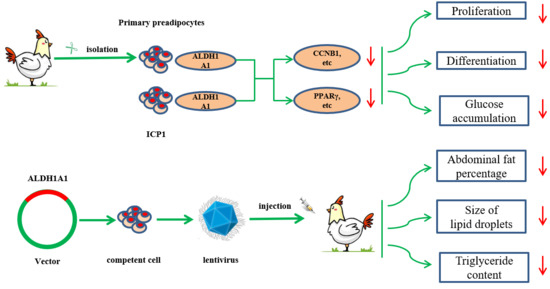ALDH1A1 Inhibits Chicken Preadipocytes’ Proliferation and Differentiation via the PPARγ Pathway In Vitro and In Vivo
Abstract
1. Introduction
2. Results
2.1. ALDH1A1 Expression in Chickens
2.2. ALDH1A1 Represses Chicken Preadipocytes’ Proliferation and Migration
2.3. ALDH1A1 Represses Chicken Preadipocytes’ Differentiation through the PPARγ Pathway
2.4. ALDH1A1 Inhibits Glucose and Triglyceride Accumulation in Chicken Preadipocytes
2.5. ALDH1A1 Inhibits Fat-Depot in Chickens
3. Discussion
4. Materials and Methods
4.1. Ethics Statement
4.2. Experimental Animals and Tissues
4.3. Lentivirus Production and Transduction
4.4. Cell Culture
4.5. RNA Isolation, Complementary DNA Synthesis, and RT-qPCR Analysis
4.6. Primers
4.7. RNA Oligonucleotides, Plasmids Construction, and Lentivirus Construction
4.8. Western Blotting Assay
4.9. EdU Assay
4.10. Analysis of the Cell Cycle
4.11. CCK-8 Experiments
4.12. Immunofluorescence Assay
4.13. Oil Red O Staining and Quantification
4.14. Triglyceride Quantification
4.15. Glucose Quantification
5. Conclusions
Supplementary Materials
Author Contributions
Funding
Conflicts of Interest
References
- Freytag, O.; Paielli, L.; Gilbert, D. Ectopic expression of the CCAAT/enhancer-binding protein alpha promotes the adipogenic program in a variety of mouse fibroblastic cells. Genes Dev. 1994, 8, 1654–1663. [Google Scholar] [CrossRef]
- Lin, F.; Lane, D. CCAAT/enhancer binding protein alpha is sufficient to initiate the 3T3-L1 adipocyte differentiation program. Proc. Natl. Acad. Sci. USA 1994, 91, 8757–8761. [Google Scholar] [CrossRef] [PubMed]
- Yeh, W.; Cao, Z.; Classon, M.; McKnight, L. Cascade regulation of terminal adipocyte differentiation by three members of the C/EBP family of leucine zipper proteins. Genes Dev. 1995, 9, 168–181. [Google Scholar] [CrossRef] [PubMed]
- Tontonoz, P.; Hu, E.; Graves, A.; Budavari, I.; Spiegelman, M. MPPAR-gamma-2: Tissue-specific regulator of an adipocyte enhancer. Genes Dev. 1994, 8, 1224–1234. [Google Scholar] [CrossRef] [PubMed]
- Schwarz, J.; Reginato, J.; Shao, D.; Krakow, L.; Lazar, A. Retinoic acid blocks adipogenesis by inhibiting C/EBP-beta-mediated transcription. Mol. Cell. Biol. 1997, 17, 1552–1561. [Google Scholar] [CrossRef] [PubMed]
- Stone, L.; Bernlohr, A. The molecular basis for inhibition of adipose conversion of murine 3T3-L1 cells by retinoic acid. Differentiation 1990, 45, 119–127. [Google Scholar] [CrossRef]
- Chawla, A.; Lazar, A. Peroxisome proliferator and retinoid signaling pathways co-regulate preadipocyte phenotype and survival. Proc. Natl. Acad. Sci. USA 1994, 91, 1786–1790. [Google Scholar] [CrossRef]
- Kuri-Harcuch, W. Differentiation of 3T3-F442A cells into adipocytes is inhibited by retinoic acid. Differentiation 1982, 23, 164–169. [Google Scholar] [CrossRef]
- Xue, J.; Schwarz, J.; Chawla, A.; Lazar, A. Distinct stages in adipogenesis revealed by retinoid inhibition of differentiation after induction of PPAR-gamma. Mol. Cell. Biol. 1996, 16, 1567–1575. [Google Scholar] [CrossRef]
- Duester, G.; Mic, A.; Molotkov, A. Cytosolic retinoid dehydrogenases govern ubiquitous metabolism of retinol to retinaldehyde followed by tissue-specific metabolism to retinoic acid. Chem. Interact. 2003, 143, 201–210. [Google Scholar] [CrossRef]
- Bowles, J.; Feng, C.; Knight, D.; Smith, A.; Roeszler, N.; Bagheri-Fam, S.; Harley, R.; Sinclair, H.; Koopman, P. Male-Specific Expression of Aldh1a1 in Mouse and Chicken Fetal Testes: Implications for Retinoid Balance in Gonad Development. Dev. Dynam. 2009, 238, 2073–2080. [Google Scholar] [CrossRef]
- Yasmeen, R.; Jeyakumar, M.; Reichert, B.; Yang, F.; Ziouzenkova, O. The contribution of vitamin A to autocrine regulation of fat depots. BBA Mol. Cell Biol. Lipids 2012, 1821, 190–197. [Google Scholar] [CrossRef]
- Molotkov, A.; Duester, G. Genetic evidence that retinaldehyde dehydrogenase Raldh1 (Aldh1a1) functions downstream of alcohol dehydrogenase Adh1 in metabolism of retinol to retinoic acid. J. Biol. Chem. 2003, 278, 36085–36090. [Google Scholar] [CrossRef] [PubMed]
- Ziouzenkova, O.; Orasanu, G.; Sharlach, M.; Akiyama, E.; Berger, P.; Viereck, J.; Hamilton, A.; Tang, G.; Dolnikowski, G.; Vogel, S.; et al. Retinaldehyde represses adipogenesis and diet-induced obesity. Nat. Med. 2007, 13, 695–702. [Google Scholar] [CrossRef]
- Chambon, P. A decade of molecular biology of retinoic acid receptors. Faseb J. 1996, 10, 940–954. [Google Scholar] [CrossRef] [PubMed]
- Heyman, A.; Mangelsdorf, J.; Dyck, A.; Stein, B.; Eichele, G.; Evans, M.; Thaller, C. 9-cis retinoic acid is a high affinity ligand for the retinoid X receptor. Cell 1992, 68, 397–406. [Google Scholar] [CrossRef]
- Hegele, A. Retinoid X receptor heterodimers in the metabolic syndrome. N. Engl. J. Med. 2005, 353, 2088. [Google Scholar] [CrossRef]
- Yasmeen, R.; Reichert, B.; Deiuliis, J.; Yang, F.; Lynch, A.; Meyers, J.; Sharlach, M.; Shin, S.; Volz, S.; Green, B.; et al. Autocrinefunction of aldehyde dehydrogenase 1 as a determinant of diet- and sex-specific differences in visceral adiposity. Diabetes 2013, 62, 124–136. [Google Scholar] [CrossRef]
- Kiefer, W.; Vernochet, C.; O’Brien, P.; Spoerl, S.; Brown, D.; Nallamshetty, S.; Zeyda, M.; Stulnig, M.; Cohen, E.; Kahn, R.; et al. Retinaldehyde dehydrogenase 1 regulates a thermogenic program in white adipose tissue. Nat. Med. 2012, 18, 918–925. [Google Scholar] [CrossRef]
- Reichert, B.; Yasmeen, R.; Jeyakumar, S.M.; Yang, F.; Thomou, T.; Alder, H.; Duester, G.; Maiseyeu, A.; Mihai, G.; Harrison, H.; et al. Concerted Action of Aldehyde Dehydrogenases Influences Depot-Specific Fat Formation. Mol. Endocrinol. 2011, 25, 799–809. [Google Scholar] [CrossRef]
- Wang, Q. RNA-Seq Screening for Genes and miRNAs Associated with Chicken Abdominal Fat Deposition. Master’s Thesis, South China Agricultural University, Guangzhou, China, 2019. [Google Scholar]
- Malladi, P.; Xu, Y.; Yang, P.; Longaker, T. Functions of vitamin D, retinoic acid, and dexamethasone in mouse adipose-derived mesenchymal cells. Tissue Eng. 2006, 12, 2031–2040. [Google Scholar] [CrossRef]
- Mercader, J.; Ribot, J.; Murano, I.; Felipe, F.; Cinti, S.; Bonet, L.; Palou, A. Remodeling of white adipose tissue after retinoic acid administration in mice. Endocrinology 2006, 147, 5325–5332. [Google Scholar] [CrossRef]
- Yang, D.; Krois, R.; Huang, P.; Wang, J.; Min, J.; Yoo, S.; Deng, Y.; Napoli, L. Raldh1 promotes adiposity during adolescence independently of retinal signaling. PLoS ONE 2017, 12, e018766911. [Google Scholar] [CrossRef]
- Ren, L.; Collingwood, N.; Rebar, J.; Wolffe, P.; Camp, S. PPAR gamma knockdown by engineered transcription factors: Exogenous PPAR gamma 2 but not PPAR gamma 1 reactivates adipogenesis. Gene. Dev. 2002, 16, 27–32. [Google Scholar] [CrossRef]
- Piastowska-Ciesielska, W.; Gajewska, M.; Wagner, W.; Dominska, K.; Ochedalski, T. Modulatory effect of selenium on cell-cycle regulatory genes in the prostate adenocarcinoma cell line. J. Appl. Biomed. 2014, 12, 87–95. [Google Scholar] [CrossRef]
- Meloche, S.; Pouyssegur, J. The ERK1/2 mitogen-activated protein kinase pathway as a master regulator of the G1- to S-phase transition. Oncogene 2007, 26, 3227–3239. [Google Scholar] [CrossRef]
- Abdalla, B.A.; Li, Z.; Ouyang, H.; Jebessa, E.; Sun, L.; Yu, J.; Cai, B.; Chen, B.; Nie, Q.; Zhang, X. A Novel Dnmt3a1 Transcript Inhibits Adipogenesis. Frotiers Physiol. 2018, 9, 1270. [Google Scholar]
- Rosen, D.; Sarraf, P.; Troy, E.; Bradwin, G.; Moore, K.; Milstone, S.; Spiegelman, M.; Mortensen, M. PPARgamma is required for the differentiation of adipose tissue in vivo and in vitro. Mol. Cell. 1999, 4, 611–617. [Google Scholar] [CrossRef]
- Frederick, P.; Johan, A. PPARγ and glucose homeostasis. Annu. Rev. Nutr. 2002, 22, 167–197. [Google Scholar]
- Wu, W.; Zhang, J.; Zhao, C.; Sun, Y.; Yin, Y.; Peng, Y.; Pang, W.; Yang, G. Lentivirus-mediated CTRP6 silencing ameliorates diet-induced obesity in mice. Exp. Cell Res. 2018, 367, 15–23. [Google Scholar] [CrossRef]
- Zhao, Z.-W.; Fan, X.-X.; Song, J.-J.; Xu, M.; Chen, M.-J.; Tu, J.-F.; Wu, F.-Z.; Zhang, D.-K.; Liu, L.; Chen, L.; et al. ShRNA knock-down of CXCR7 inhibits tumour invasion and metastasis in hepatocellular carcinoma after transcatheter arterial chemoembolization. J. Cell. Mol. Med. 2017, 21, 1989–1999. [Google Scholar] [CrossRef]
- Cheng, J.; Li, Y.; Wu, G.; Zheng, J.; Lu, H.; Shi, X.-E.; Yang, G. Ectopic expression of RBP4 impairs the insulin pathway and inguinal fat deposition in mice. J. Physiol. Biochem. 2014, 70, 479–486. [Google Scholar] [CrossRef]
- Fan, H.; Wu, D.; Tian, W.; Ma, X. Inhibitory effects of tannic acid on fatty acid synthase and 3T3-L1 preadipocyte. Biochim. Biophys. Acta 2013, 1831, 1260–1266. [Google Scholar] [CrossRef]
- Cryer, J.; Woodhead, B.; Cryer, A. The isolation and characterization of a putative adipocyte precursor cell type from the white adipose tissue of the chicken (Gallus domesticus). Comp. Biochem. Physiol. A 1987, 86, 515–521. [Google Scholar] [CrossRef]
- Butterwith, S.; Griffin, H. The effects of macrophage-derived cytokines on lipid metabolism in chicken (Gallus domesticus) hepatocytes and adipocytes. Comp. Biochem. Physiol. 1989, 94, 721–724. [Google Scholar] [CrossRef]
- Yusuke, M.; Kan, S.; Hiroshi, I.; Yukio, A. Changes in mRNA expression of regulatory factors involved in adipocyte differentiation during fatty acid induced adipogenesis in chicken. Comp. Biochem. Physiol. 2005, 141, 108–115. [Google Scholar]
- Livak, J.; Schmittgen, D. Analysis of relative gene expression data using real-time quantitative PCR and the 2-DELTADELTACT method. Methods 2001, 25, 402–408. [Google Scholar] [CrossRef]
- Ting, Z.; Buhao, D.; Ruixin, Z.; Xuze, Q.; Jianxin, Z.; Junxing, Z. Dietary Sea Buckthorn Pomace Induces Beige Adipocyte Formation in Inguinal White Adipose Tissue in Lambs. Animals 2019, 9, 193. [Google Scholar]
- Zhang, K.; Wang, F.; Huang, J.; Lou, Y.; Xie, J.; Li, H.; Cao, D.; Huang, X. Insulin-like growth factor 2 promotes the adipogenesis of hemangioma-derived stem cells. Exp. Ther. Med. 2018, 17, 1663–1669. [Google Scholar] [CrossRef]
- Du, J.; Zhang, P.; Gan, M.; Zhao, X.; Xu, Y.; Li, Q.; Jiang, Y.; Tang, G.; Li, M.; Wang, J.; et al. MicroRNA-204-5p regulates 3T3-L1 preadipocyte proliferation, apoptosis and differentiation. Gene 2018, 668, 1–7. [Google Scholar] [CrossRef]
- Cai, B.; Li, Z.; Ma, M.; Wang, Z.; Han, P.; Abdalla, B.A.; Nie, Q.; Zhang, X. LncRNA-Six1 Encodes a Micropeptide to Activate Six1 in Cis and Is Involved in Cell Proliferation and Muscle Growth. Front. Physiol. 2017, 8, 595. [Google Scholar] [CrossRef] [PubMed]
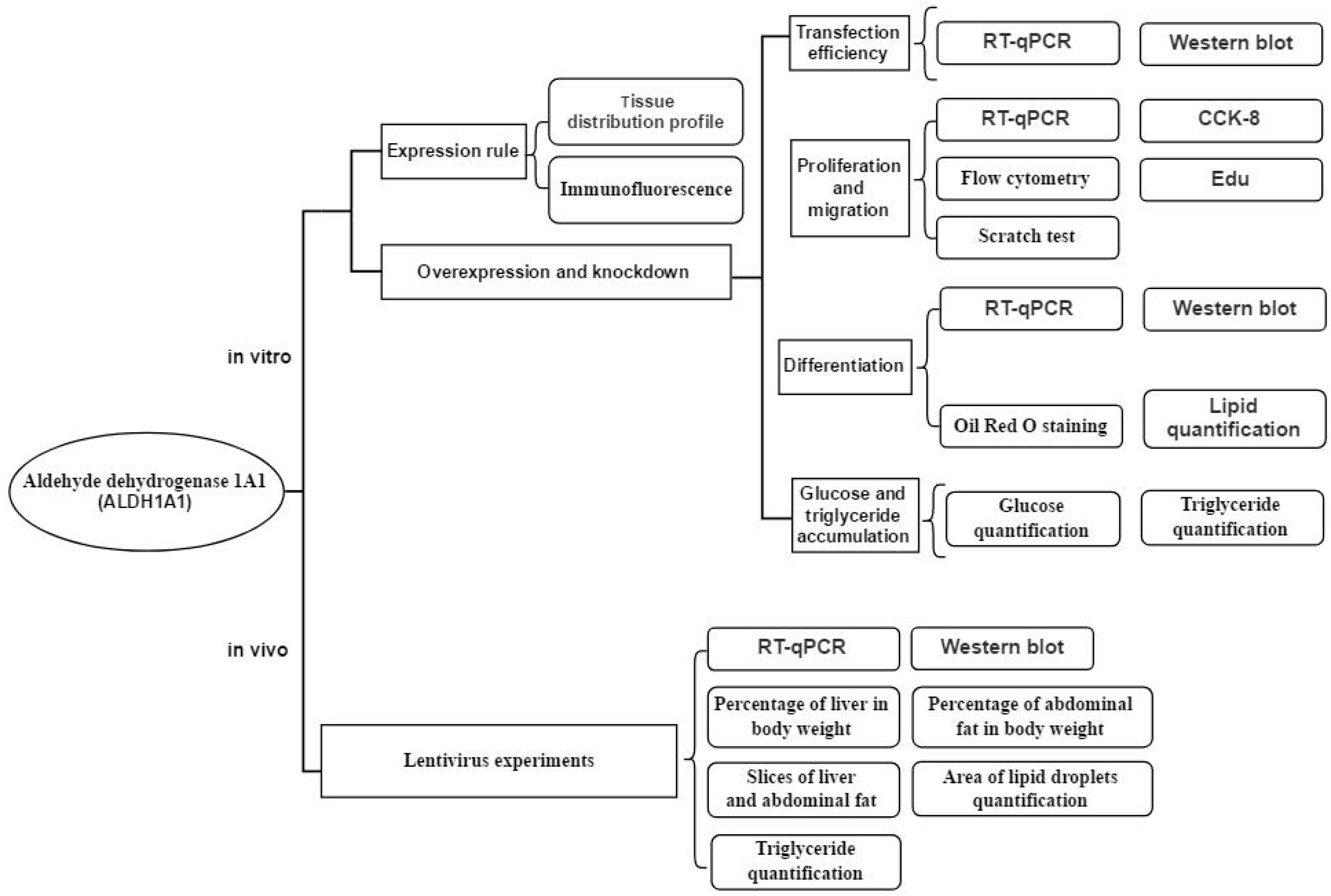
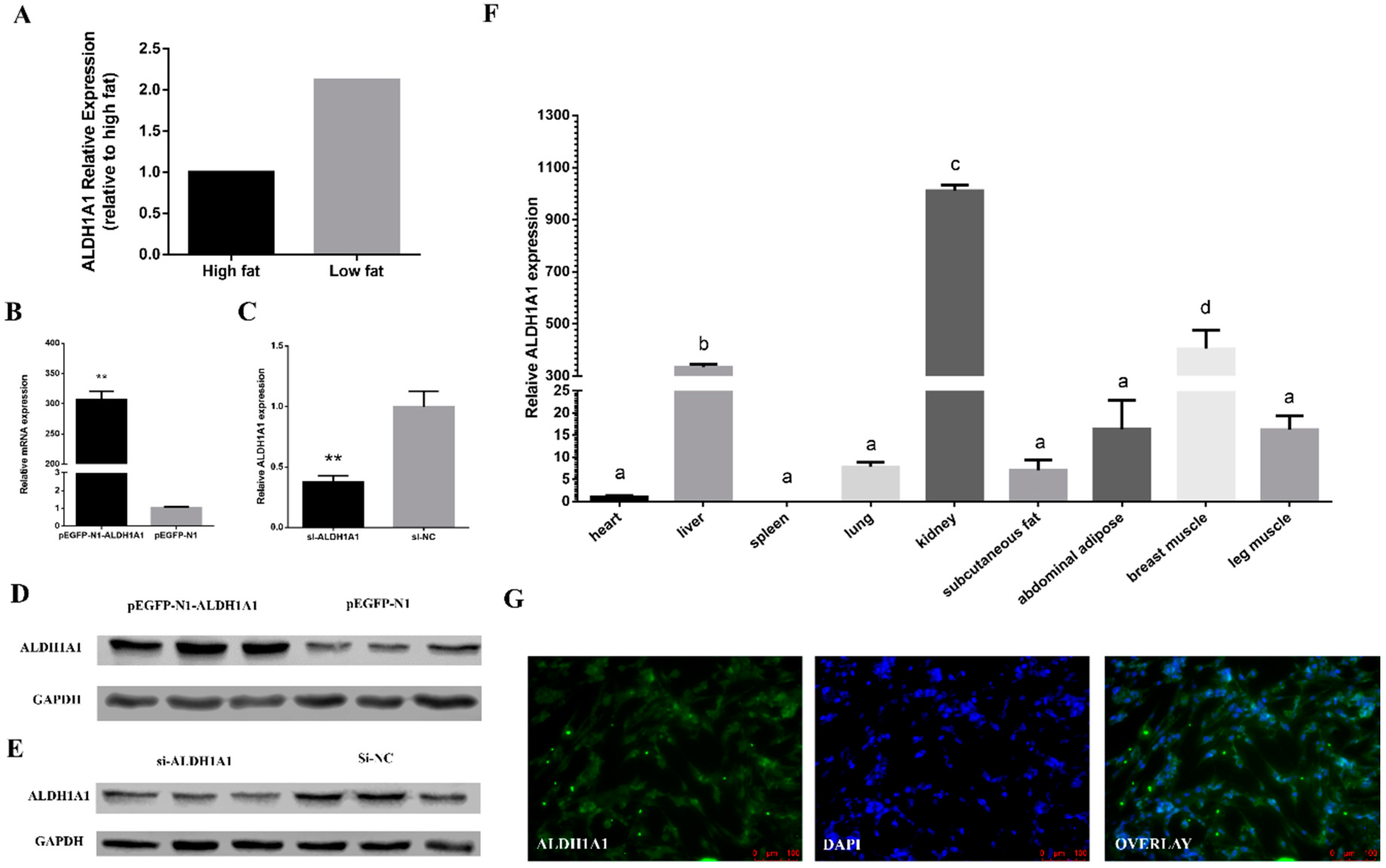
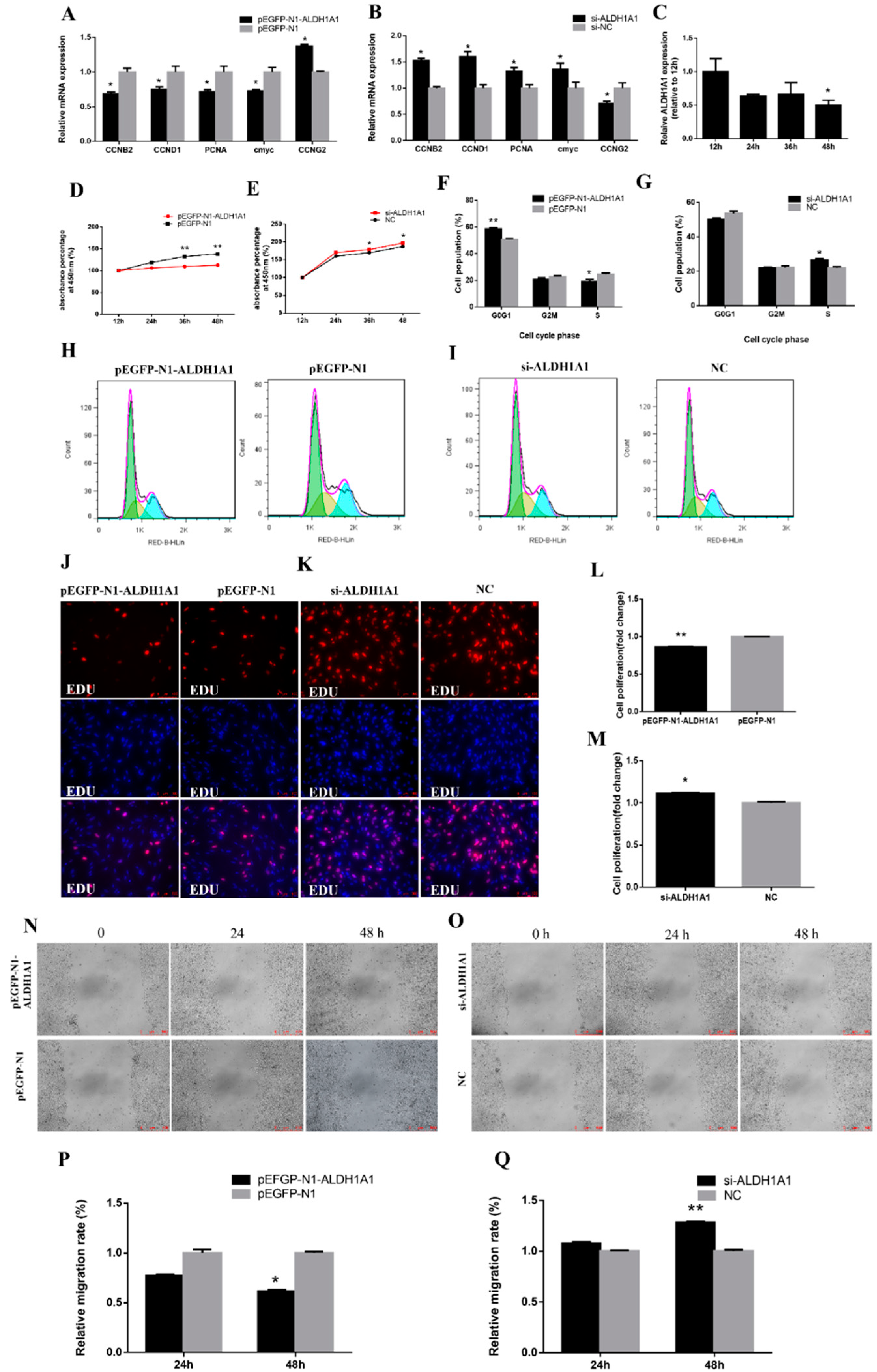


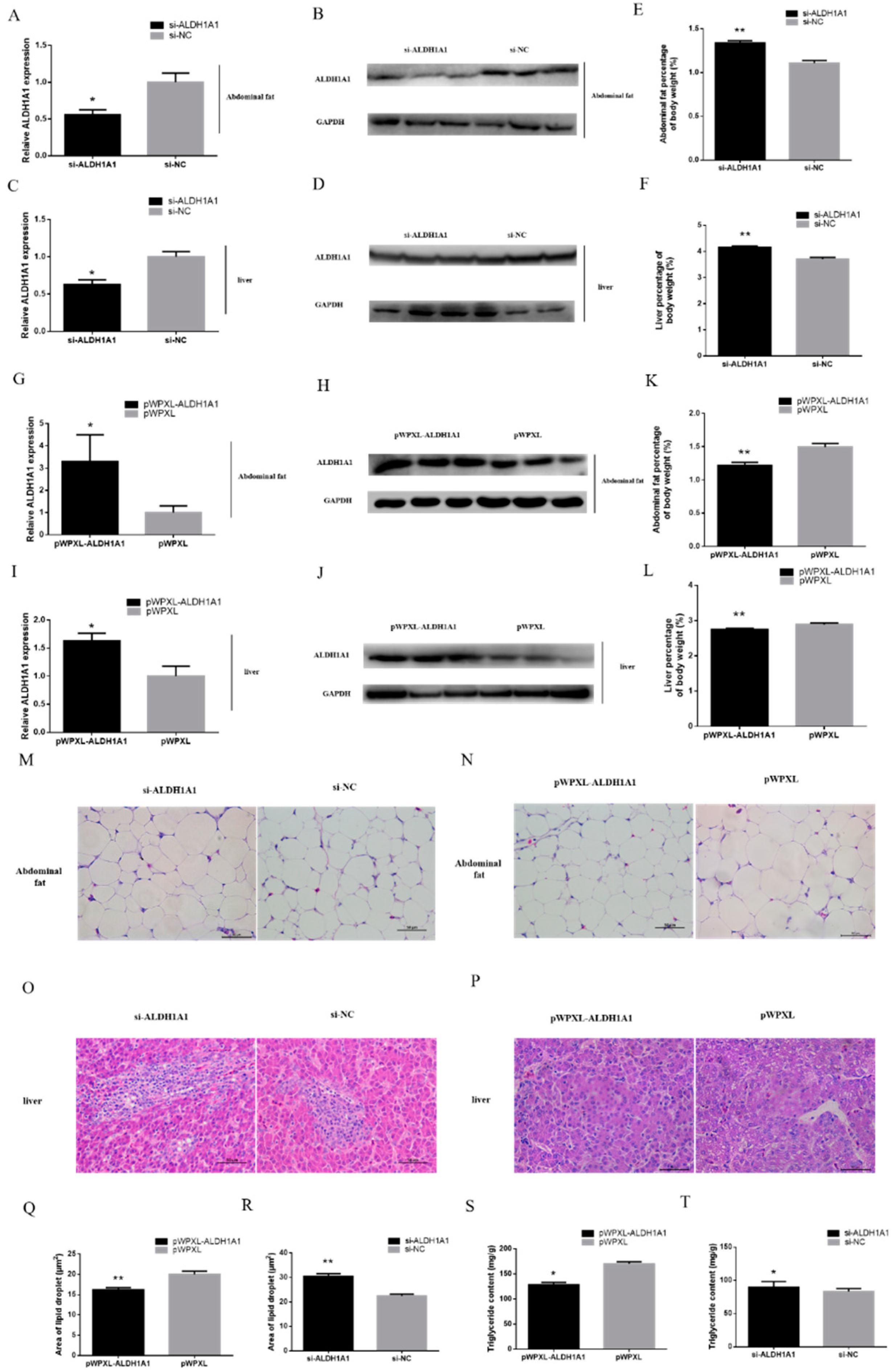
| Groups | Body Weight (g) | Mass of Abdominal Fat (g) | Abdominal Fat Percentage (%) |
|---|---|---|---|
| High Fat | 1659.93 ± 60.61 | 146.95 ± 8.58 ** | 8.83 ± 0.28 ** |
| Low Fat | 1472.63 ± 68.49 | 53.67 ± 4.35 | 3.62 ± 0.17 |
© 2020 by the authors. Licensee MDPI, Basel, Switzerland. This article is an open access article distributed under the terms and conditions of the Creative Commons Attribution (CC BY) license (http://creativecommons.org/licenses/by/4.0/).
Share and Cite
Zhang, J.; Cai, B.; Ma, M.; Luo, W.; Zhang, Z.; Zhang, X.; Nie, Q. ALDH1A1 Inhibits Chicken Preadipocytes’ Proliferation and Differentiation via the PPARγ Pathway In Vitro and In Vivo. Int. J. Mol. Sci. 2020, 21, 3150. https://doi.org/10.3390/ijms21093150
Zhang J, Cai B, Ma M, Luo W, Zhang Z, Zhang X, Nie Q. ALDH1A1 Inhibits Chicken Preadipocytes’ Proliferation and Differentiation via the PPARγ Pathway In Vitro and In Vivo. International Journal of Molecular Sciences. 2020; 21(9):3150. https://doi.org/10.3390/ijms21093150
Chicago/Turabian StyleZhang, Jing, Bolin Cai, Manting Ma, Wei Luo, Zipeng Zhang, Xiquan Zhang, and Qinghua Nie. 2020. "ALDH1A1 Inhibits Chicken Preadipocytes’ Proliferation and Differentiation via the PPARγ Pathway In Vitro and In Vivo" International Journal of Molecular Sciences 21, no. 9: 3150. https://doi.org/10.3390/ijms21093150
APA StyleZhang, J., Cai, B., Ma, M., Luo, W., Zhang, Z., Zhang, X., & Nie, Q. (2020). ALDH1A1 Inhibits Chicken Preadipocytes’ Proliferation and Differentiation via the PPARγ Pathway In Vitro and In Vivo. International Journal of Molecular Sciences, 21(9), 3150. https://doi.org/10.3390/ijms21093150





